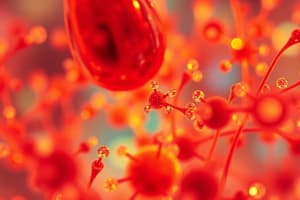Podcast
Questions and Answers
What is the primary function of a microscope?
What is the primary function of a microscope?
- To magnify an image and allow visualization of greater detail than the unaided eye. (correct)
- To assess surface properties of cells and other biological objects.
- To provide light to illuminate objects.
- To quantify tissue mass.
Which of the following is not a type of light microscopy mentioned in the text?
Which of the following is not a type of light microscopy mentioned in the text?
- Electron (correct)
- Bright-field
- Simple
- Compound
What is the role of the condenser lens in a bright-field microscope?
What is the role of the condenser lens in a bright-field microscope?
- To provide the light source.
- To hold the microscope slide.
- To magnify the image 10x.
- To collect and focus light on the object to be studied. (correct)
What is the key difference between the interference microscope and the differential interference microscope (Nomarski)?
What is the key difference between the interference microscope and the differential interference microscope (Nomarski)?
What is the primary advantage of using a phase-contrast microscope?
What is the primary advantage of using a phase-contrast microscope?
What is the purpose of the ocular lens (eyepiece) in a bright-field microscope?
What is the purpose of the ocular lens (eyepiece) in a bright-field microscope?
What is the key difference between polyclonal and monoclonal antibodies in immunocytochemical staining procedures?
What is the key difference between polyclonal and monoclonal antibodies in immunocytochemical staining procedures?
What is the primary purpose of using a dark-field microscope clinically?
What is the primary purpose of using a dark-field microscope clinically?
Which microscopy technique is best suited for visualizing the smallest resolvable distance between points?
Which microscopy technique is best suited for visualizing the smallest resolvable distance between points?
What is the key difference between a direct fluorescence assay (dFA) and an indirect fluorescence assay?
What is the key difference between a direct fluorescence assay (dFA) and an indirect fluorescence assay?
Which microscopy technique is best suited for examining autoradiographs and demonstrating specific bacteria?
Which microscopy technique is best suited for examining autoradiographs and demonstrating specific bacteria?
What is the primary advantage of using monoclonal antibodies over polyclonal antibodies in immunocytochemical staining procedures?
What is the primary advantage of using monoclonal antibodies over polyclonal antibodies in immunocytochemical staining procedures?
Flashcards are hidden until you start studying




